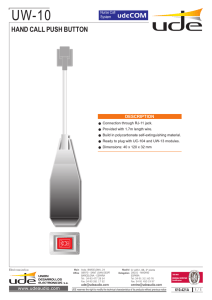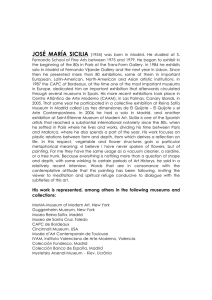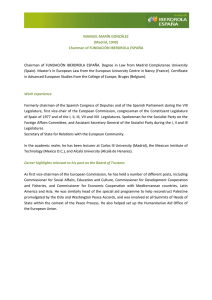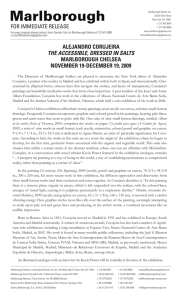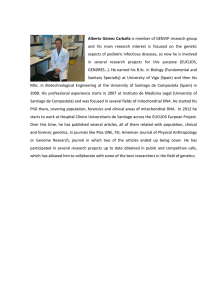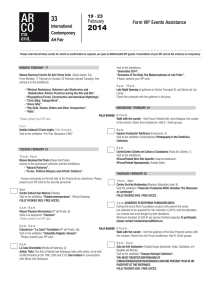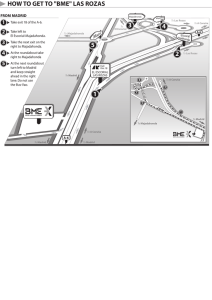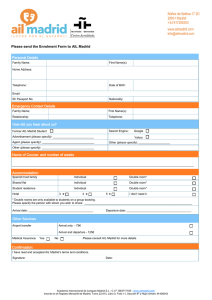PDF - Curators` Network
Anuncio
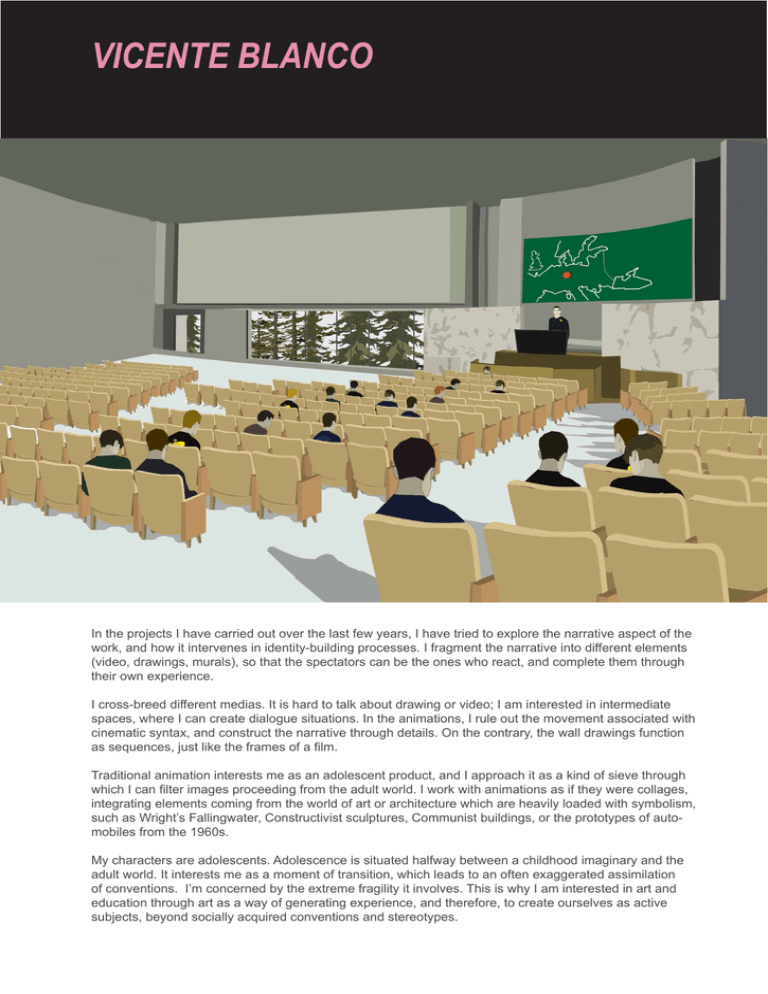
VICENTE BLANCO In the projects I have carried out over the last few years, I have tried to explore the narrative aspect of the work, and how it intervenes in identity-building processes. I fragment the narrative into different elements (video, drawings, murals), so that the spectators can be the ones who react, and complete them through their own experience. I cross-breed different medias. It is hard to talk about drawing or video; I am interested in intermediate spaces, where I can create dialogue situations. In the animations, I rule out the movement associated with cinematic syntax, and construct the narrative through details. On the contrary, the wall drawings function as sequences, just like the frames of a film. Traditional animation interests me as an adolescent product, and I approach it as a kind of sieve through which I can filter images proceeding from the adult world. I work with animations as if they were collages, integrating elements coming from the world of art or architecture which are heavily loaded with symbolism, such as Wright’s Fallingwater, Constructivist sculptures, Communist buildings, or the prototypes of automobiles from the 1960s. My characters are adolescents. Adolescence is situated halfway between a childhood imaginary and the adult world. It interests me as a moment of transition, which leads to an often exaggerated assimilation of conventions. I’m concerned by the extreme fragility it involves. This is why I am interested in art and education through art as a way of generating experience, and therefore, to create ourselves as active subjects, beyond socially acquired conventions and stereotypes. What we are expected to do, View of the exhibition at the CGAC, Santiago de Compostela, 2003 To develop this view, It was very important my studies in Arteleku, and my work as a teacher at the University of Santiago de Compostela, where I experienced the problems of the educational system to help teachers and students to go beyond conventions. Experiences that, in some way, were the starting point of most of my present work. For the exhibition “Lo que se espera de nosotros” (What is Expected of Us) at the Galician Centre of Contemporary Art I used constructivism as a link between aesthetics and ideology. Through a mural with a map of Europe which covered the space and two back-projections, I elaborate an juvenile organization which was shown to the spectator as a image; its infrastructure, architecture, means of transportation, and so on. However, there was another back-projection, hidden from the main room, which showed another aspect of the organization, its flip side, and how the interweaving of personal relationships amongst its members could have a tragic impact on the organization’s carefully elaborated image. What we are expected to do, View of the exhibition at the CGAC, Santiago de Compostela, 2003 Alguna vez pasa cuando estais dormidos/ Sometime it happens when you get asleep, View of the exhibition at the MNACRS, 2004 For the Espacio Uno project I constructed a large landscape following romantic landscape conventions. I built up the image in various layers like a collage, selecting different elements (flowers, trees, hills, clouds...) from old postcards. I drew each of the elements individually, superimposing them and colouring them until they disappeared leaving only the image. In this way all the complex process of production remained concealed. However, I wanted the relationship of the forces between image and structure, contemplation and construction to be revealed at a certain moment. The impact of the structure of lights that appear one after the other focuses attention on the detail and the landscape disappears, thus making the spectator question the conventional way of looking at landscape. At the same time I built another animated sequence taking place from inside a room. We see through the window a van driving up and stopping in front of the house. The sequence consists of a horizontal sweep, but the movement of the camera is in slow motion and doesn't coincide with the development of the action. The camera stops and focuses on each element in the room (the television with the images of the Atomium), oblivious of the conversation between the two characters, encouraging the observer to concentrate on the details. I placed this scene in the exhibition room half-concealed by the landscape. I wanted it to be possible to establish a relationship between them, to make them interact as image and structure, folding over one another so that our experience would be a reflection of the experience of the characters. The proll thing, VideoStills, 2005 The work “ The proll thing” comprises an animated video on two screens, and another video of real image. The idea is to distribute the narrative into different media, and see how this information acquires different levels in the exhibition space. My starting point was the Kino International Restaurant in East Berlin. This building’s current “image policy” prohibits taking photographs inside of it (although it is open to the public during film screenings). I thought about animation as the medium to depict the inside of the building, since it would be possible to recreate the interior in such a way as to mix reality and fiction. To make this setting, I integrated different elements, some of them real, others imaginary, creating new situations. The drawings for the video’s sets were based on a series of postcards which are sold as souvenirs at the entrance to the cinema. I was interested in the relation ship between my own experience (looking in from an outside entrance to the building, from which I could see the tables closest to its picture windows), and the visual information contained in the postcards. Now, what is happening in a city like Berlin is that the recent past maintains a presence through many symbols (the monument to Russians fallen in World Ward II, the telecommunication Tower, the wide boulevards typical on the Communistic aesthetic). I’m interested in the moment, right now, when these symbols’ usages are changing very quickly. The old Café Moskau, where the Communist elite used to pamper itself, is now a gay disco; the old Palace of the Republic is now used for skateboard competitions. Although at first, these were spaces created to establish doctrines, today, with the rapid adjustment of these uses and symbols, they are producing new meanings, maintaining their nature as social place, for meeting or exchange. Coreografía” 2008Fundación ICO In the next videos “Otra vez algo nuevo” and “Coreografía” 2007 and “Contrato para paisaje” 2009, I am working with animated versions of movies by Pasolini and Luis Buñuel. I will explain the realization with more detail in the pdf about my project. Contrato para paisaje, 2009, Gelerie van der Mieden VICENTE BLANCO Cee (A Coruña), 1974 EDUCACIÓN 1999 Práctica y Límites de la Escultura, Cursos de Doctorado en la Universidad del País Vasco, Bilbao, España 1997 Licenciado en Bellas Artes, Especialidad Escultura. Facultad de Pontevedra, Universidad de Vigo, España SOLO EXHIBITION 2009 Contrato para paisaje, Galerie van der Mieden, Amberes 2006 Otra vez algo nuevo, Galería Elba Benítez, Madrid 2006 The Proll Thing. 16 proyectos de arte español, ARCO’ 06, Madrid 2004 Alguna vez pasa cuando estáis dormidos, Espacio Uno, Museo Nacional Centro de Arte Reina Sofía, Madrid, 2003 Lo que se espera de nosotros, CGAC, Centro Galego de Arte Contemporánea, Santiago de Compostela, 2002 Oh, oh, oh, oh yeah!, Galería Marisa Marimón, Ourense 2001 Transeuropa Xpress, Bratislava en dos segundos, Ciclo Miradas Vírgenes, Centro Torrente Ballester, Ferrol, 1998 Luces de artificio, Galería Sargadelos, Santiago de Compostela GROUP SHOWS 2011 Colección III, Centro de Arte 2 de Mayo, Madrid Región 0. The Latino Video Art Festival. Centro Rey Juan Carlos I, Nueva York. Big Screen Proyect, Nueva York 2010 89 Km, MARCO, Vigo Art Amsterdam, Galerie van der Mieden, Amsterdam Bienal de Arte Fundación María José Jove, A Coruña XXV años Muestra de Arte Injuve, Antigua Fabrica de Tabacos, Circulo Bellas Artes, Madrid Merrie Melodies (y otras 13 maneras de entender el dibujo) DA2, Salamanca XXXI Salón de Otoño, Itinerante, Extremadura. 2009 XV Película de Pel, Galería Marisa Marimón Hybrid Generations: Forms and Languages of Video-Art in Spain, CIGE 2009, Stand Casa Asia, Pekín Rencontres Internacionales, Haus der Kulturen der Welt, Berlin / Auditorium Sabatini, Museo Nacional Centro de Arte Reina Sofía, Madrid Realidades, expresiones, tramas. Arte en Galicia desde 1975, Fundación Caixa Galicia, Pontevedra Rexistros Abertos, Museo Provincial, Lugo. 2008 Rencontres Internationales Paris/Berlin, Centre Pompidou, Beaux Arts, Paris Exposición Becarios Endesa 9, Museo de Teruel Parangolé, Museo Patio Herreriano de Valladolid, Valladolid, España Mixed Emotions. Apuntes para una colección del siglo XXI DA2 - Domus Artium 2002, Salamanca “Miradas de hoy” Instituto Cervantes de Varsovia 2007 Fantasmagoría Dibujo en Movimiento, Fundación ICO, Madrid Geopolíticas de la animación, CAAC, Sevilla, MARCO, Vigo El Puente de la visión, Museo de Bellas Artes de Santander Aquí y ahora, Sala Alcalá, Madrid Destino Santiago, Instituto Cervantes Praga e Instituto Cervantes Berlin. Existencias MUSAC - Museo de Arte Contemporáneo de Castilla y León, Léon XLIV Certamen Internacional d’Arts Plàstiques de Pollença 2007. Museu de Pollença, Pollença O debuxo por diante, CGAC - Centro Galego de Arte Contemporánea, Santiago de Compostela 2006 ¿Viva pintura!, Hangar 7, Salzburgo, Austria 16 proyectos de arte español, espacio comisariado por Maria Corral, ARCO’ 06, Madrid Urbanitas, MARCO, Museo de Arte Contemporáneo de Vigo, Vigo, Becas Unión Fenosa, MACUF, A Coruña Destino Santiago de Compostela, Instituto Cervantes de Sofía, Bulgaria XVI Certamen de Artes Plásticas de la UNED, Madrid Contos dixitais, CGAC, Santiago de Compostela 2005 2004 Enlaces. Museo Patio Herreriano de Valladolid, Valladolid, Expoactual. Galeria DV, San Sebastián, España Quinzaine Hispanique, Instituto Bossuet, Condom-enˆArmagnac, Touluse, 2003 Monocanal, MNCARS, Itinerante Edición Madrid, Palacio de las Tentaciones, Madrid, Loop‚OO. Art, Barcelona 2002 Narrando espacios, tiempos, historias. XXVII Bienal de Pontevedra, Pontevedra Figuraciones: Arte civil, magicismos, espacios de fronteras. Itinerante Exposición Artistas nominados Francia-España, Prix Altadis, Paris 2001 Figuraciones. Centro de Arte Joven de la Comunidad de Madrid, Madrid; Edificio Sarmiento, Museo de Pontevedra, Pontevedra, Arte emergente. Sociedad Estatal España Nuevo Milenio. Estación Marítima de A Coruña, A Coruña, España 2000 Transfer 2000-2001, CGAC, Centro Galego de Arte Contemporánea, Santiago de Compostela; Palacio de Revillagigedo, Gijón; Sala Rekalde, Bilbao, España; Städtisches Museum Leverkusen Schlob Morsbroich; Willhelm Lehmbruck Museum Duisburg, Städtisches Museum Abteiberg Mönchengladbach; Gessellschft für Zeitgenössische Kunst, Essen, Alemania Bloody Nose, Main Gallery CGU, Los Ángeles, USA Waves, Festival de Vídeo de Los Ángeles, Los Ángeles, USA Generación 2000, Caja Madrid. Itinerante 1999 Muestra de Arte Joven, Círculo de Bellas Artes, Madrid, España 1998 Exposición taller de Ángel Bados y Txomin Badiola, Arteleku, San Sebastián; Centro Cultural Montehermoso, Vitoria, España SCHOOLARSHIPS AND PRIZES 2010 Premio Internacional Bienal de Arte Fundación María José Jove 2008 I Premio Estampa Comunidad de Madrid 2005-2007 Beca Endesa 2003-2005 Beca Unión Fenosa, Künstfabrik, Berlín, Alemania 2000-2001 Beca de Proyectos Generación 2000, Caja Madrid, Madrid, España 1999-2000 Beca de La Diputación de A Coruña para Ampliación de Estudios Artísticos, CGU, Los Ángeles, California, USA 1996-1997 Beca de Colaboración en el Departamento de Expresión Artística, Universidad de Vigo, España
